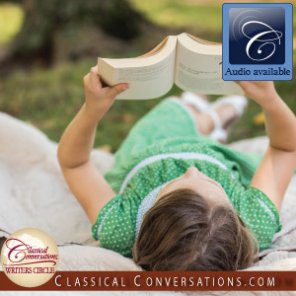Have you ever felt intimidated by a book? Are there any authors who overwhelm you simply by reputation? Tolstoy perhaps? Famous for Anna Karenina and War and Peace, he is not exactly known for brief or immediately accessible literature. How about Nathaniel Hawthorne, Aldous Huxley, or T. S. Eliot? What about Charles Dickens? Sure, you know and have probably seen a few too many amateur theater renditions of A Christmas Carol, but what about A Tale of Two Cities? Our Mutual Friend? Oliver Twist? Would you like to impart to your children a greater ability to read, discuss, and appreciate these authors than you had when you completed your formal education? I know this is certainly a goal for me.
As a classical educator, I desire that by the time my daughter is ready to graduate from high school, she will have the tools of learning at her disposal—that no field of inquiry will be closed to her, no author will be off limits for her. There are many ways that we are working to accomplish this—such as mastering the weekly memory work in Foundations and studying the structure of language in Essentials—but reading and discussing good books together has always been our most fruitful strategy in this endeavor.
Several years ago, I made a wonderful discovery that has rendered this approach even more rewarding. Did you know that each of the authors mentioned in the opening paragraph, while primarily famous for their books for adults, also wrote stories for children? Can you imagine your children being introduced to “The Waste Land” and exclaiming, “T. S. Eliot? Oh, I love him!” They will if you have read “Old Possum’s Book of Practical Cats” with them. War and Peace will sound significantly less intimidating to your students when they have read Childhood, Leo Tolstoy’s semi-autobiographical novel about a ten-year-old boy growing up in pre-revolutionary Russia. They will have developed a personal relationship with Tolstoy and will want to get to know him better. The mention of The Scarlet Letter will be less likely to daunt your Challenge I students if they have encountered Hawthorne’s engaging retellings of Greek myths for children in A Wonder Book and Tanglewood Tales. Similarly, I am confident that A Tale of Two Cities will immediately strike your Challenge II student as a more compelling title in the syllabus if they have previously enjoyed Charles Dickens through his rollicking fairytale “The Magic Fish-Bone.”
Certainly the themes, plots, and characters of their children’s literature differ in significant ways from the authors’ offerings for adults; but then again, there are many similarities. Eliot’s poetry is richly satisfying, and his turns of phrase are surprising and wonderful whether you encounter him in his magnum opus the “Four Quartets,” in his landmark modernist poem “The Love Song of J. Alfred Prufrock,” or in his whimsical verses about amusing cats. His use of language is exquisite throughout. Tolstoy’s penetrating insights into human character, motivations, and interactions enrich each of his works, Childhood included.[i] Unsurprisingly, Hawthorne’s retellings of Greek myths are structured in ways that also allow him to reflect and remark on New England culture. Dickens’ charming fairy tale “The Magic Fish-Bone” introduces the ingredients of poverty, resourcefulness, and rapid fluctuations of fortune that permeate his many novels.
I would like to use “The Magic Fish-Bone” to share some ideas on how you might use these wonderful stories to help your children make an early personal acquaintance with some of the best authors. This particular tale is the story of the princess Alicia, the eldest of nineteen children aged seven months to seven years, and her impoverished parents King Watkins the First and his wife the Queen. At a stop by the fishmongers on his way to work, King Watkins encounters the good Fairy Grandmarina who explains that, as a present from her, Alicia will find a fishbone on her plate that evening, which she must clean, dry, polish, and save. It will grant her one wish, but only if she chooses to make her wish at the right time. Grandmarina’s prediction comes to pass. However, the following morning a series of misfortunes, illnesses, and accidents begins to occur to the family, and with each successive crisis, the Princess Alicia must discern whether it is the right time to make her wish. She wisely infers from Grandmarina’s rather cryptic message the circumstances necessary for the wish to be granted, and she patiently reserves her wish for the perfect moment. The incredible events that take place in response to her wish are too surprising and entertaining to relate here. You will simply have to read the book. Find it for as little as one cent on Amazon!
One of the first things your children may notice when you read the book together is the liberal use of synonyms and the repetition of certain words, phrases, or verbal exchanges throughout the story. While the repetition certainly contributes to the tone and development of the story, it also offers the perfect time to mention that, for most of his career, Dickens wrote serialized stories for periodicals and was paid by the word. Ask your children to observe instances of repetition, and to consider what purpose they may serve in the story—whether building suspense, reminding the reader of the qualifications for the wish, or simply filling a word quota. For instance, the king goes to his office where “he wrote and wrote and wrote, till it was time to go home again.” This depiction of King Watkins’ day may represent a child’s simplistic view of what her father does at work. Could it also serve to pad the text a little bit? Yet, would the tedious nature of the father’s job have been fully communicated by one “wrote”? To extend the discussion, consider offering your Essentials student a penny per word for their next composition, and just see if they don’t come up with a few more quality adjectives than in previous assignments!
You may also notice that Dickens rarely uses personal pronouns when titles or other descriptions will do. So, the good Fairy Grandmarina is never “she” but is always “the good Fairy Grandmarina,” “the old lady,” or very occasionally simply “the lady.” Encourage your children to consider how referring to her in this way heightens her distinction, but also challenge them to find out how much this simple practice padded the story’s word count. With these conversations, you will have introduced your children to recognizable features of Dickens prose that will appear wherever they encounter him later.
You will see frequent references to the impoverished King’s discouragement that quarter-day never seems to arrive, but is always a long way off. This is an excellent opportunity to briefly sketch an outline of Dickens’ poverty-stricken childhood, and to ask them to consider what the implications of being paid quarterly rather than bi-weekly might be. Can they see how careful money-management and savings would be paramount under those circumstances, and how even families with several working members like the Dickens family were susceptible to stints in debtors’ prison when unanticipated financial obligations came up? You may also consider introducing your older children to the British currency system before decimalization in 1971. In so many of Dickens’ novels, as well as in the rest of the British literature they encounter, your children will benefit from an understanding of the approximate values of a farthing, penny, shilling (or bob), florin, crown, pound, quid, and sovereign. For example, in A Christmas Carol, we learn that Bob Cratchit earns fifteen bob a week. What kind of yearly salary is he bringing home? Is the family really as destitute as we naturally assume them to be?
Other significant and recurring themes that we experience through the story of the princess Alicia are children who feel an enormous amount of responsibility for their families; children who may in some respects be wiser or more admirable than the adults in their lives; and justice being served through sudden, unexpected reversals of fortune—both good and bad.
So grab “The Magic Fish-Bone” from your local library (which is where we found it), or order a copy for your family, and get ready for a wonderful story and some great conversations. And be on the lookout! I have absolutely not exhausted the list of well-known authors who have written for children. The Nobel Prize winning author Pearl S. Buck wrote some lovely children’s Christmas stories; her “Christmas Day in the Morning” is a family favorite. Oscar Wilde’s The Happy Prince and Other Stories is a rich collection of tales that you will ponder long after you have closed the volume. So take advantage of these fantastic opportunities to meet these authors in their own words and on their own terms through their children’s literature. It will prepare your children for the themes, styles, and structures of the adult works. It will train them to love beautiful language, artfully composed sentences, and complex plots and characters. It will leave them eager to meet the authors again.
I think our next read may be Upton Sinclair’s The Gnomobile: A Gnice Gnew Gnarrative with Gnonsense, but Gnothing Gnaughty. I suspect that when it comes time to read The Jungle, we won’t feel intimidated at all.
[i] Because human character, motivations, and interactions are not always what we would desire them to be, I would wait to read this with children of dialectic age. The young antagonist is transparent with his fluctuating emotions—affection, rage, envy, love, contentment, sorrow—as he navigates many unfamiliar situations including the death of his beloved mother.




